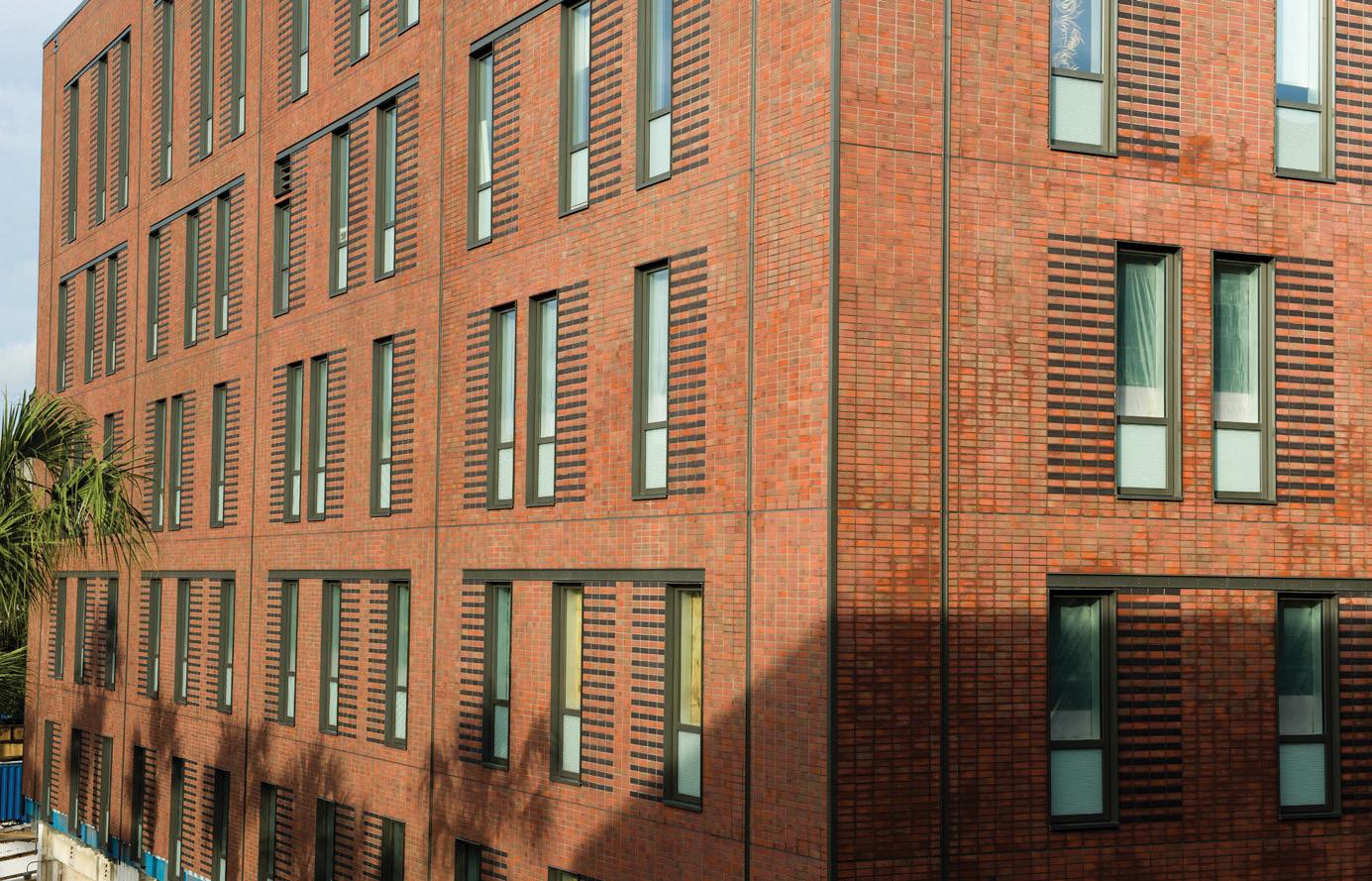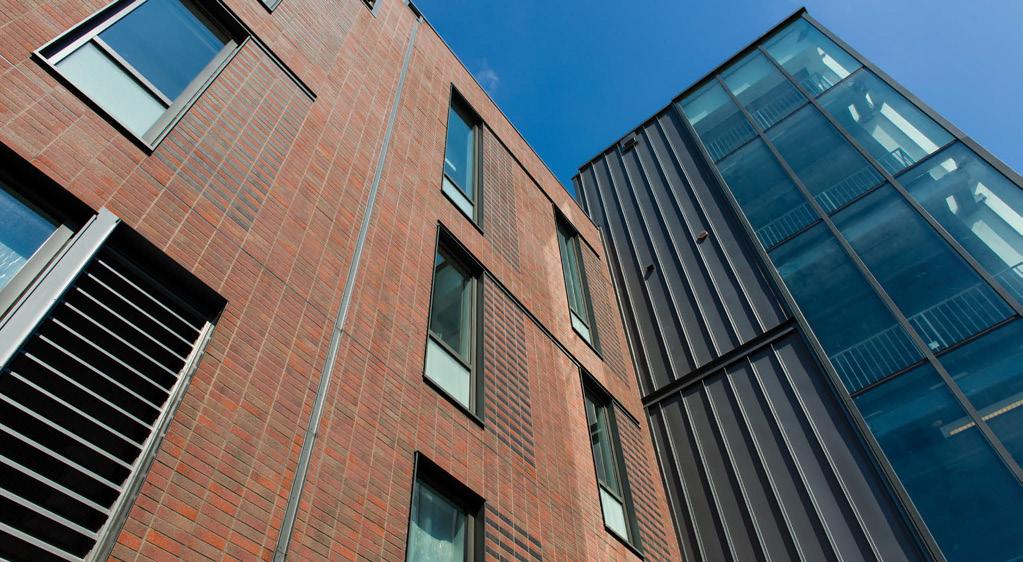
6 minute read
Brick System Revitalizes University Building
from commARCH - June 2015
by IdeaSoil
Part of a campus-wide renovation, plans for Monroe Hall included a new façade to reconfi gure the windows and allow the massive building to appear similar to other campus structures.
Brick System Revitalizes University Building Pressure-equalized brick rainscreen wall system ensures weather tightness and energy effi ciency.
Advertisement
The J. Edgar Monroe Memorial Science Building at Loyola Univ., New Orleans, was the largest classroom facility on campus when constructed in 1969. At the time, the Post-Modern fi berglass façade was seen as a symbol of the future.
Over the years, it has become less a symbol of modern-day science and more the oddity on campus—not quite blending with the more traditional brick buildings around the main courtyard. Aside from its pale exterior and porthole-shaped windows, Monroe Hall also lacked the energy-efficiency and high-performance features that are part of more contemporary construction.
Part of a campus-wide renovation, plans for Monroe Hall included adding 114,000 sq. ft. to the building, along with a new façade to reconfigure the windows and allow the massive building to appear similar to other campus structures. To accomplish this goal, the original plans for renovation called for a new high-performance façade with a terra-cotta panel system that would stand up to the high humidity and harsh climate events common to New Orleans. When costs came in over budget, the university looked for an alternative.
POSITIVE ATTRIBUTES
The owners hoped to find a façade that would incorporate not only the performance expected with the terra-cotta system, but also yield an attractive, traditional appearance, consistent with traditional brick masonry.
A Corium brick rainscreen system was brought to the attention of the owners by Randall Rush of Rush Masonry, New Orleans. Positive attributes, including the system’s appearance and performance features, were considered prior to the decision to substitute the cladding system for the terra-cotta façade. “Traditional brick wasn’t a possibility,” said Rush, “Monroe Hall wasn’t designed for full masonry weight. The cladding system was less than half the weight of conventional masonry.”
According to Gregory P. Lusignan, vice president of Broadmoor LLC, Metairie, LA, general contractor for the Monroe Hall project, “The whole project was over budget. We had to value-engineer, and Corium allowed us to save a substantial amount of money. It also ended up pretty closely matched to existing brick facades around the cam
pus.” Lusignan added, “I think from the brick installation standpoint, the level of skilled labor isn’t as demanding with Corium as it is with brick installation.”
The cladding system also could be configured to provide the performance features desired in the renovation. According to engineering consultant Randy J. Wilson, PE, Toronto, “The biggest challenge has always been to convince contractors of the merits of pressure-equalized/ rainscreen (PR/RS) wall systems. Canadian and European wall contractors have long held the belief that PR/RS walls are the best way to ensure weather tightness, energy efficiency, and overall superior performance. Resistance has been met in the U.S. for many years, but I believe the tide has changed as U.S. wall contractors are embracing the concept of air tightness and rainscreen wall performance,” he said.
Wilson added, “From a technical and performance standpoint, the Corium wall assembly was a breath of fresh air. It was obvious that the wall assembly would be perfect for the New Orleans climate. High humidity, driving rain, and extremely punishing wind pressures could be handled by this fully tested and proven system. The decision was easy for me to recommend the brick-veneer rainscreen for the Loyola University project.”
The brick rainscreen system can be installed by carpenters, sheet-metal workers, glazers, façade contractors, as well as masons, according to Steve Collins, vice president, Telling Architectural LLC, Cranston, RI, the U.S. distributor of Corium.
Collins explained that a typical brick-veneer installation is a multi-trade, multi-jurisdictional, complex, and expensive process. “A brick facade, along with bricks, mortar, and ties, also requires additional concrete to support the weight of the bricks. This brings in the concrete contractors with foundations and caissons. At 40 psf [lb./sq. ft.], brick is one of the heaviest façade materials used today. A brick veneer includes steel relieving angles around the perimeter of the building at every floor to support the brick,” he said.
“At the top of and across every opening, windows, doors, etc., you have steel lintels to support the brick,” he continued. “These steel ledges are designed into every building and are installed by the iron workers. In order to support a brick veneer, which is quite rigid, a stronger steel wall is necessary. Heavier gauge steel is necessary to accommodate design loads, adding considerable money and labor for the steel erectors. Additionally, all of the steel, ties, and lintels are thermal breaks, making conformance to ASHRAE 90.1 that much more difficult, if not impossible.” “Overlaying all of this, the ranks of bricklayers are thinning,” Collins observed. “There are not many young men or women coming out of high school and signing up for the bricklayer training programs. The industry is well aware of this. In conversation with many of the mason contractors and International Masonry Institute (IMI)

Monroe Hall wasn’t designed for full masonry weight, therefore a cladding system was chosen that is less than half the weight of conventional masonry but gives the appearance of traditional brick.
representatives it is clear that the industry is losing people, quality, and market share. Given that brick remains a very basic building block of American construction this would be shame if this trend were not reversed.”
EUROPEAN ROOTS The system is produced by Wienerberger AG, Vienna, Austria, a major worldwide producer of bricks. The Corium system is a fully engineered, rainscreen system with 15 years of application in Europe. At 14 lb./ sq. ft. it is considerably lighter than conventional brick veneers. It is fi xed with a steel and aluminum framing system that allows continuous insulation, uninterrupted air/ moisture barriers, and provides an open cavity for drainage, convection air, moisture management, and pressure equalization.
The bricks are high-compressive-strength, high-density, severe-weather bricks, extruded to meet tight tolerances for dimensional stability. Each brick is permanently fixed into roll-formed trays designed to hold the profiled bricks. The trays are interlocked, forming a drainage plane behind the bricks. The support framing system allows varying depths of cavity, insulation, or design depth of the system.
The system has been successfully tested for ASTM (ASTM Int’l, West Conshohocken, PA,) and AAMA (American Architectural Manufacturers Association, Schaumburg, IL) requirements for curtainwall construction. The Monroe project at Loyola Univ. required additional testing to 200 mph because New Orleans is in a hurricane zone.
Improving energy efficiency was also an objective of the renovation. The original structure was built prior to the many changes in building codes that were put in place during the 1970s to reduce energy consumption and enhance the overall performance of buildings. The brick rainscreen system allows as much as 5 in. of continuous insulation and an uninterrupted air/moisture barrier, providing the opportunity to maximize thermal performance.
By using the Corium brick system, the university was able to reduce the cost of materials for the project, achieve the necessary insulating values to improve the building’s energy efficiency, and create an aesthetic façade consistent with other campus structures. CBP
Want more information? The resources below are linked in our website and digital magazine at cbpmagazine.com/digital/jun2015.
Circle 3 on the Reader Service Card.
Download a Corium spec sheet.
Read the Corium brochure. Download guidelines for the pointing of Corium brick cladding.
View a case study of a Corium application at Exeter Hospital, UK.







